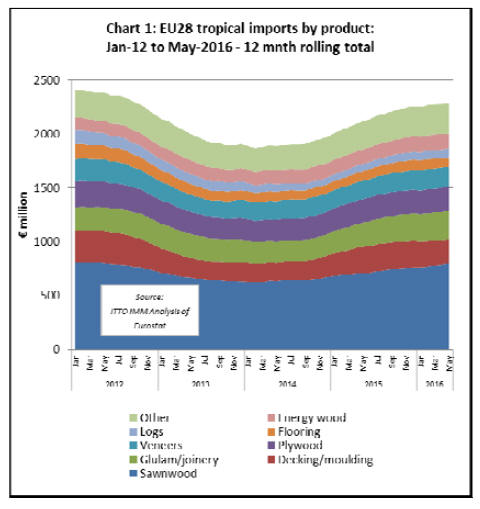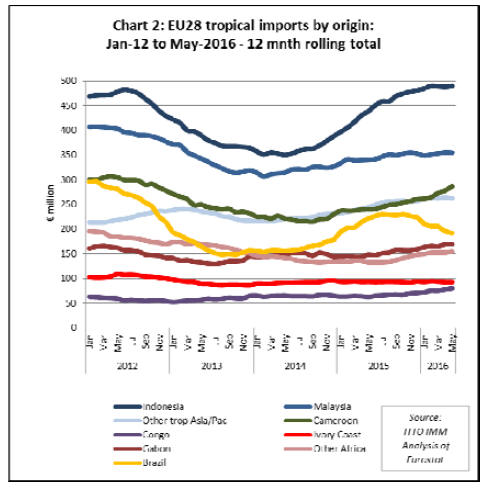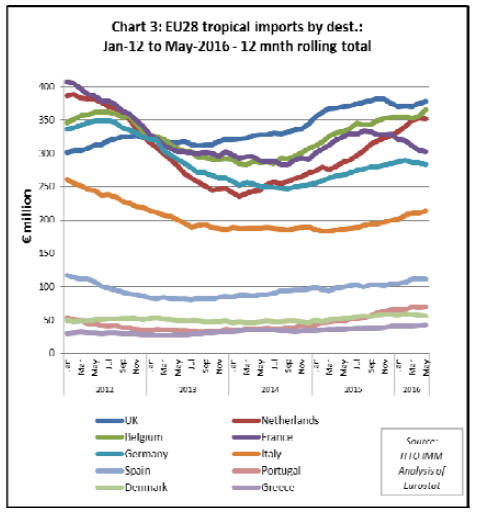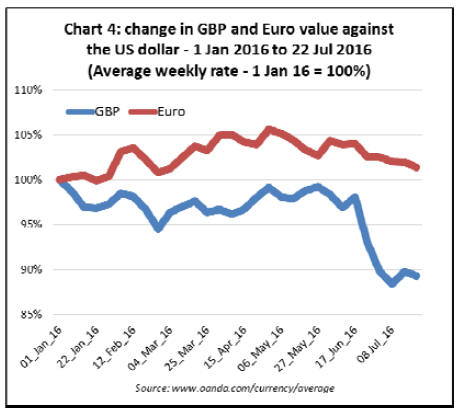|
Report from
Europe
Slowing pace of EU tropical timber imports
Latest trade data shows that the rising trend in EU import
value of tropical wood products that began in the second
half of 2014 levelled off in the first five months of this
year. No trade data is yet available for the period after
May when the effects of the UK vote to leave the EU
might become clearer.
Early indications are that it will lead to a significant
slowdown in European tropical wood imports in the
second half of 2016 in response to currency movements
and economic uncertainty in the UK, currently the largest
European market for tropical wood products.
Charts 1 to 3 below show the monthly trends in imports of
tropical wood products into the EU to May 2016 using 12
month rolling totals. This is calculated for each month as
the total import of the previous 12 months. The data
removes short-term fluctuations due to seasonal changes in
supply and shipping schedules and provides a clear
indication of the underlying trade trend.
Chart 1 shows total EU euro import value of all wood
products listed in Chapter 44 of the HS codes sourced
from tropical countries. Total imports in the 12 months to
May 2016 were euro2.29 billion, only slightly above
euro2.26 billion recorded for the 12 months of 2015.
The sharp increase in imports of tropical decking and
mouldings recorded in 2015, notably from Brazil and into
the UK and France, has slowed dramatically in 2016.
Imports of tropical flooring products have also slowed this
year.
However, European imports of tropical sawnwood, veneer,
logs, energy wood and joinery products such as LVL
continued to rise between January and May 2016. After
recovering in 2014, European imports of tropical plywood
remained static between January 2015 and May 2016.

Chart 2 shows how European imports from the major
tropical supply countries developed between 2012 and
May 2016. After rapid growth in 2015 and the first quarter
of 2016, European imports from Indonesia (dominated by
decking, doors, plywood and LVL) stabilised at the higher
level in April and May this year.
Imports from Malaysia (mainly sawnwood, plywood,
doors, and LVL) remained static at a relatively low level
between mid-2015 and May 2016. Imports from
Cameroon (almost all sawnwood) were rising sharply in
the year to May. However, imports from Brazil (mainly
sawnwood and decking) fell rapidly between September
2015 and May 2016.

Chart 3 shows the recent trend in tropical wood imports
into the main EU consuming countries. The pace of
growth in imports into the UK (the leading EU market
which takes mainly doors, plywood and sawnwood) was
already slowing in the early months of 2016 before the
Brexit vote.
Imports into Belgium (mainly sawnwood and decking) and
the Netherlands (mainly sawnwood, LVL and decking)
continued to rise in the first five months of 2016,
narrowing the gap with the UK. Imports have also
continued to rise this year into Italy (mainly sawnwood
and veneer), Spain (mainly sawnwood and veneer) and
Portugal (mainly sawnwood, logs and chips).
In contrast, imports into France (mainly sawnwood,
decking and veneer) were declining during the first five
months of 2016, due to weakening imports from Brazil.
Imports into Germany (mainly decking and sawnwood)
also dipped a little in April and May this year.

Lower European imports expected in second half of
2016
The fall-out from the Brexit vote on 23 June, combined
with challenging economic conditions in other parts of the
Europe, particularly Italy, is likely to lead to a downturn in
European imports in the second half of 2016.
Feedback from UK timber importers in the aftermath of
the Brexit referendum vote on 23 June is that their most
immediate concern is the exchange rate.
The value of the British pound, which increased from 1.41
to 1.50 against the US dollar in the days leading up to the
referendum on the expectation that ¡°Remain¡± would win,
fell sharply to a 30-year low of $1.29 on 6 July after the
result. By 22 July it had recovered only slightly to $1.31.
The euro, already low against the US dollar after a
dramatic fall in late 2014 and early 2015, also weakened
following the referendum from $1.14 on 22 June to
euro1.10 on 22 July (Chart 4).

UK import prices for hardwoods, particularly when
invoiced in dollars, have therefore increased sharply since
the referendum and a prolonged hiatus in purchasing is
now expected. Merchants and manufacturers already
appear to be hunting for landed stock before looking to
order from overseas. The extent to which prices for stock
already landed in the UK now also rise depends on
availability and the extent to which consumption slows in
response to wider economic uncertainty.
For now, UK importers report there is good availability of
landed stock of most of the key commercial hardwoods.
Overall there is probably enough stock on the ground to
tide the bulk of the UK market over the summer months.
There¡¯s therefore likely to be a sharp slowdown in orders
from UK importers at least until September and probably
longer.
UK importers report that sales to manufacturers and
merchants did not dry up after the referendum, although
buying was quiet for the last week of June when there
would usually be an uptick in activity. There are reports of
some UK customers, while not placing new orders,
sending out long lists of requirements. As one agent
commented, ¡°it looks like they are fishing for new price
structures as nobody is yet sure where the market will
settle¡±.
No one yet knows what the real economic impact will be
of the Brexit vote. But of course markets generally don¡¯t
like change or uncertainty and the Brexit process means
that the period of uncertainty will be prolonged. Some
major investors will delay decisions, while tens of
thousands of smaller investors will also wait to see what
happens. Government tax receipts and spending are likely
to be curtailed. This is likely to dampen economic growth
in the UK over the next couple of years or more.
Early indications are that the short-term economic impact
of Brexit has been severe in the UK. Following the
referendum, major house builders in the UK suffered
initial blows to their future forecasts and analysts are
predicting a slowdown in the market along with increased
costs of 10-12% for major construction projects, leading to
more being put on ice.
The UK Purchasing Managers Index (PMIs) compiled by
Markit dropped to 47.7 in July from 52.4 in June, the
sharpest one-month drop on record and a decisive shift
from expansion to contraction (50 being the threshold
value). Both services and manufacturing recorded sharp
declines, with a small silver lining being an apparent
increase in new export business, helped by the steep drop
in the British pound.
But there are some reasons for optimism. The indexes
stand in contrast to a report published on 20 July by the
Bank of England based on interviews with businesses
around the UK saying there had been no clear evidence of
a sharp slowing in activity, although uncertainty had risen.
¡¡
And the PMI may have been coloured by political
uncertainty that has decreased with the relatively rapid
appointment of a new British Prime Minister on 13 July.
No sign yet of Brexit contagion
There is also no sign yet of any significant contagion from
the Brexit vote in other European markets. The Markit
Flash Eurozone Manufacturing PMI came in at 51.9 in
July, down from 52.8 in June but only slightly below
market expectations of 52.
Although Eurozone export growth slowed in part due to
lower sales to the UK this was offset by increased export
orders to other markets due to the weaker euro.
In Germany, the widely watched IFO business climate
index dipped to 108.3 in July from 108.7 in June. That was
both better than expected and the second-highest outcome
this year. In other words, business expectations slid, but
only marginally.
The French economy has shown signs of improvement this
year with latest GDP data to end March 2016 registering
the strongest annual expansion since 2011. Even after the
British vote to leave the EU, both the finance ministry and
the International Monetary Fund (IMF) maintained their
forecasts for France to show growth of 1.5% in 2016.
However, the strength of economic recovery is still
uncertain.
The Markit composite PMI for France stood at 50 in July,
the threshold that divides expansion from contraction. The
data suggests a continued slump in French manufacturing
output which is erasing a return to growth in services.
Apart from Brexit, weakness in the Italian economy
remains the primary concern in the EU. Italy's economy is
unlikely to return to pre-crisis levels for close to a decade,
according to the IMF.
Italian banks now have an estimated euro360 billion of
non-performing loans, reflecting around 20% of Italy¡¯s
GDP and 15% of all its banking system¡¯s loans (which
compares to around 5% in the U.S. during in the 2008-09
banking crisis).
The problem is not a real estate bubble, but low growth,
deflation, and lack of competitiveness ¡ª exacerbated by a
euro exchange rate which is over-valued from the
perspective of Italian manufacturers.
Exchange rate will also be the key concern of the
European timber trade in the months ahead. Forecasting
the euro dollar exchange rate is extremely difficult given
political and economic uncertainty on both sides of the
Atlantic.
But drawing on the recent better-than-expected economic
signals in Germany and with no signs yet of any change in
ECB monetary policy, most forecasters suggest relative
stability in the euro-dollar rate for the time-being.
However, the UK Financial Times is reporting that the
majority of analysts they follow are forecasting a notably
weaker British pound in the months ahead. There is a
widespread expectation, fed by public statements by the
Governor of the Bank of England about the need for
economic stimulus, that the UK interest rate will be cut
from the current 0.5%, at least to 0.25%, perhaps even to
zero in the next few months.
In addition to a hoped for boost in spending, this would
tend to reduce inflows of foreign capital into the UK and
create further downward pressure on the exchange rate.
Therefore, it might be some time before UK importers are
encouraged back into the tropical timber market in any
volume.
|